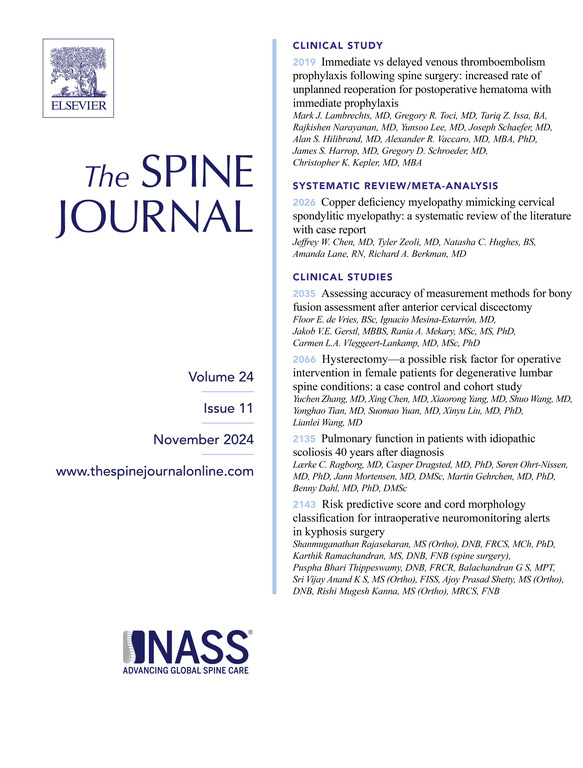用退行性脊柱侧凸的种族调整后总体对齐和比例评分预测术后机械并发症:脊柱旁肌肉变性是否重要?
IF 4.9
1区 医学
Q1 CLINICAL NEUROLOGY
引用次数: 0
摘要
背景:全球对齐和比例(GAP)评分是为了预测成人脊柱畸形手术后的机械并发症(MCs)而开发的,但在亚洲人群中显示出有限的敏感性。考虑到不同种族人群矢状面参数的差异,我们的团队根据 566 名无症状中国志愿者的脊柱骨盆参数,制定了经种族调整的 GAP 评分(C-GAP 评分)。值得注意的是,脊柱侧弯退行性变(DS)患者在接受矫正手术后,脊柱旁肌肉退行性变更为严重。对于不同矢状排列的脊柱侧弯患者,分布不均的脊柱旁肌肉退变可能会对MC的发生产生不同的影响,并在很大程度上影响C-GAP评分在临床评估中的准确性。目的:我们旨在明确脊柱旁肌肉变性对预测DS手术后MC发生的C-GAP评分的影响,并利用脊柱旁肌肉变性参数修改C-GAP评分:样本量:107例成年退行性脊柱侧凸患者:人口统计学信息、术后矢状脊柱参数、GAP评分、C-GAP评分和脊柱旁肌肉变性参数:方法:对107名接受后路脊柱融合手术(≥4个椎体)且至少随访2年(或在2年内经历过MC)的DS患者进行回顾性研究。他们的 C-GAP 评分是根据我们之前的研究计算得出的,患者被分为 3 个 C-GAP 类别:"比例"(P)、"中度比例失调"(MD)和 "严重比例失调"(SD)。使用磁共振成像(MRI)对 L1/2、L2/3、L3/4 和 L4/5 椎间盘的相对横截面积(肌肉-椎间盘横截面积比×100,rCSA)和脂肪浸润率(FI%)进行定量评估。在每个C-GAP类别中,患者还被分为MC组和非MC组,以分析他们的脊柱旁肌肉变性情况。由 CSA 加权平均 FI%(总 FI%)和 C-GAP 评分(C-GAPM)构建了一个多变量逻辑回归模型。接受者操作特征曲线(ROC)的曲线下面积(AUC)用于评估 GAP 评分、C-GAP 评分、FI% 和 C-GAPM 的可预测性。该项目得到了国家自然科学基金(编号:82272545)和江苏省科技计划专项基金(编号:BE2023658)的资助:在所有107例患者中,MC组(32例)L1/2、L2/3、L3/4和L4/5椎间盘的FI%和总FI%明显高于非MC组(75例)。3个原始GAP类别、P、MD和SD类别的MC率分别为25.00%(6/24)、27.03%(10/37)和34.78%(16/46)(χ2=0.944,P=0.624)。根据 C-GAP 评分,P、MD 和 SD 类别的 MC 率分别为 11.90%(5/42)、34.69%(17/49)和 62.50%(10/16),差异显著(χ2=15.137,P=0.001)。在 C-GAP MD 类别中,与非 MC 组(n=32)相比,MC 组(n=17)的总 FI% 较高(26.16(22.95, 34.00) vs. 22.67(16.39, 27.37)),p=0.029)。在 C-GAP SD 类别(34.79±11.56 vs. 19.00±5.17,p=0.007)中也发现了类似的趋势,但在 C-GAP P 类别(25.09(22.82, 32.66) vs. 24.66(17.36, 28.63),p=0.361)中没有发现。GAP评分、C-GAP评分、总FI%和C-GAPM的AUC分别为0.601、0.722、0.716和0.772:在 C-GAP MD、SD 而非 P 类别中,脊柱旁肌肉变性对 MC 的发生有显著影响。将脊柱旁肌FI%与C-GAP评分(C-GAPM)相结合,可以更准确地预测DS手术后的MC。外科医生在为 C-GAP MD 和 SD 类患者制定手术计划和进行术后管理时,应充分关注脊柱旁肌肉变性。本文章由计算机程序翻译,如有差异,请以英文原文为准。
Predicting postoperative mechanical complications with the ethnicity-adjusted global alignment and proportion score in degenerative scoliosis: does paraspinal muscle degeneration matter?
Background
The global alignment and proportion (GAP) score was developed to predict mechanical complications (MCs) after adult spinal deformity surgery but showed limited sensitivity in the Asian population. Considering variations in sagittal parameters among different ethnic groups, our team developed the ethnicity-adjusted GAP score according to the spinopelvic parameters of 566 asymptomatic Chinese volunteers (C-GAP score). Notably, degenerative scoliosis (DS) patients with MCs following corrective surgery have more severe paraspinal muscle degeneration. For DS patients with various sagittal alignments, the unevenly distributed degeneration of paraspinal muscle may exert different influences on MC occurrence and largely affect the accuracy of the C-GAP score in clinical assessment. Therefore, incorporating paraspinal muscle degeneration indices within the C-GAP score may improve its accuracy in predicting MC occurrence.
Purpose
We aimed to clarify the influence of paraspinal muscle degeneration on the C-GAP score predicting MC occurrence following DS surgery and modify the C-GAP score with paraspinal muscle degeneration parameters.
Study Design
A retrospective case-control study.
Sample Size
A total of 107 adult degenerative scoliosis patients.
Outcome Measures
Demographic information, postoperative sagittal spinopelvic parameters, the GAP score, the C-GAP score, and paraspinal muscle degeneration parameters.
Methods
A total of 107 DS patients undergoing posterior spinal fusion surgery (≥4 vertebrae) with a minimum of 2 years follow-up (or experiencing MCs within 2 years) were retrospectively reviewed. Their C-GAP score was calculated based on our previous study and patients were divided into 3 C-GAP categories, “proportioned” (P), “moderately disproportioned” (MD), and “severely disproportioned” (SD). Relative cross-sectional area (cross-sectional area of muscle–disc ratio×100, rCSA) and fat infiltration rate, FI% at L1/2, L2/3, L3/4, and L4/5 discs were quantitatively evaluated using magnetic resonance imaging (MRI). In each C-GAP category, patients were additionally divided into the MC group and the non-MC group to analyze their paraspinal muscle degeneration. A multivariable logistic regression model consisting of the CSA-weighted average FI% (total FI%) and the C-GAP score, C-GAPM was constructed. The area under the curve (AUC) of the receiver operating characteristic (ROC) curves was used to evaluate the predictability of the GAP score, the C-GAP score, FI%, and C-GAPM. This project was supported by the National Natural Science Foundation of China (No.82272545) and Special Fund of Science and Technology Plan of Jiangsu Province (No.BE2023658).
Results
For all 107 patients, FI% at L1/2, L2/3, L3/4, and L4/5 discs and the total FI% of the MC group (n=32) were significantly higher than those of the non-MC group (n=75). The MC rates of 3 original GAP categories, P, MD, and SD categories were 25.00% (6/24), 27.03%(10/37), and 34.78% (16/46) (χ2=0.944, p=.624). Based on the C-GAP score, the MC rates of the P, MD, and SD categories were 11.90% (5/42), 34.69% (17/49), and 62.50% (10/16), showing significant differences (χ2=15.137, p=.001). In the C-GAP MD category, compared with the non-MC group (n=32), the MC group (n=17) has a higher total FI% (26.16(22.95, 34.00) vs 22.67(16.39, 27.37)), p=.029). A similar trend was identified in the C-GAP SD category (34.79±11.56 vs 19.00±5.17, p=.007), but not in the C-GAP P category (25.09(22.82, 32.66) vs 24.66(17.36, 28.63), p=.361). The AUC of the GAP score, the C-GAP score, the total FI%, and C-GAPM were respectively 0.601, 0.722, 0.716, and 0.772.
Conclusions
Paraspinal muscle degeneration exerts a significant effect on the occurrence of MC in the C-GAP MD, SD instead of P category. The integration of paraspinal muscle FI% with the C-GAP score (C-GAPM) enables a more accurate prediction of MCs following DS surgery. Surgeons should pay adequate attention to paraspinal muscle degeneration during surgical planning and postoperative management for patients in the C-GAP MD and SD categories.
求助全文
通过发布文献求助,成功后即可免费获取论文全文。
去求助
来源期刊

Spine Journal
医学-临床神经学
CiteScore
8.20
自引率
6.70%
发文量
680
审稿时长
13.1 weeks
期刊介绍:
The Spine Journal, the official journal of the North American Spine Society, is an international and multidisciplinary journal that publishes original, peer-reviewed articles on research and treatment related to the spine and spine care, including basic science and clinical investigations. It is a condition of publication that manuscripts submitted to The Spine Journal have not been published, and will not be simultaneously submitted or published elsewhere. The Spine Journal also publishes major reviews of specific topics by acknowledged authorities, technical notes, teaching editorials, and other special features, Letters to the Editor-in-Chief are encouraged.
 求助内容:
求助内容: 应助结果提醒方式:
应助结果提醒方式:


